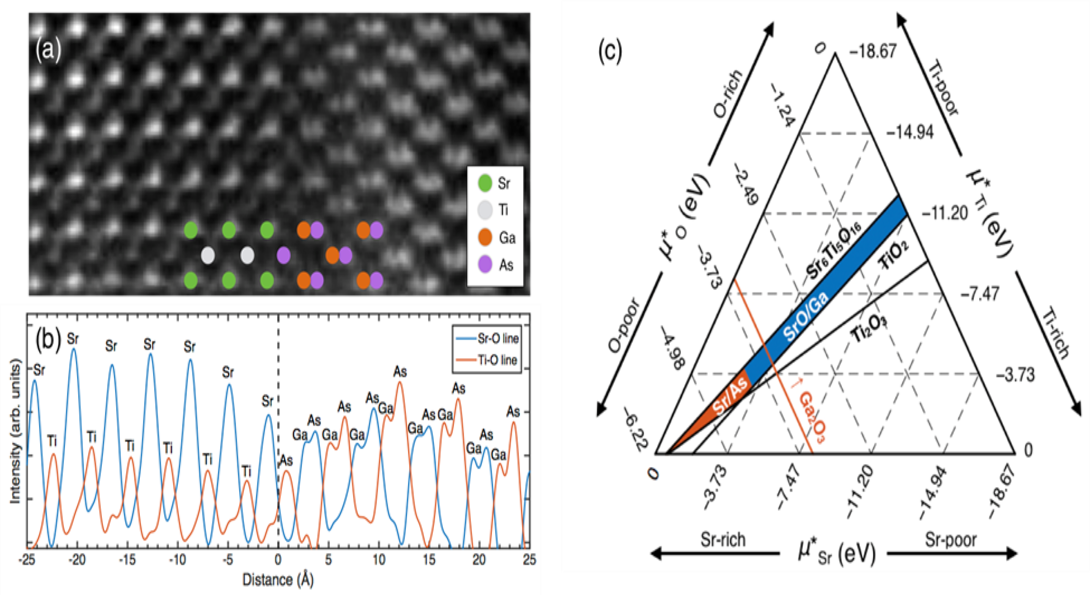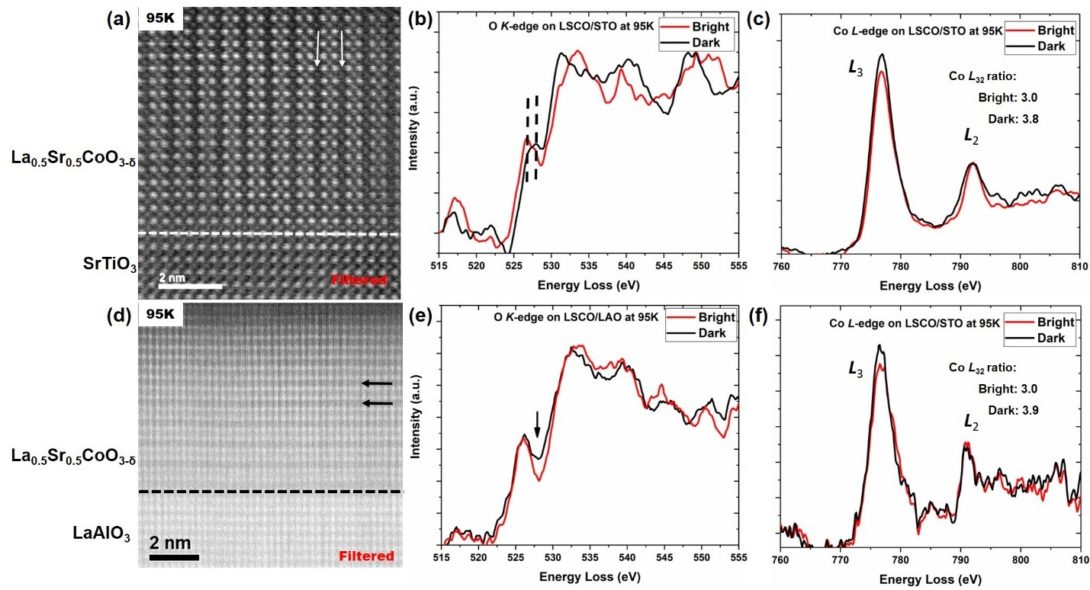Perovskite Oxides
Perovskite Oxides Heading link

Ferroelectric metal-oxide thin films grown on semiconductor substrates are being studied due to their potential applications in non-volatile single transistor memory elements. Epitaxial single-crystalline BaTiO3 (BTO) thin film was successfully grown on polar GaAs substrate with a SrTiO3 (STO) interlayer using molecular beam epitaxy method. We focus on the atomic-scale characterization and analysis of heterostructures of oxide thin films and semiconductors using aberration-corrected scanning transmission electron microscopy (STEM) techniques and first-principles modeling. The electronic properties of epitaxial oxide thin films grown on compound semiconductors are largely determined by the interfacial atomic structure, as well as the thermodynamic conditions during synthesis. Ferroelectric polarization and Fermi-level pinning in SrTiO3 films have been attributed to the presence of oxygen vacancies at the oxide/semiconductor interface.
Atomic-resolution STEM and EELS analyses of GaAs films grown on SrTiO3 combined with first-principles calculations to determine the atomic and electronic structures of the SrTiO3/GaAs interfaces. An atomically abrupt SrO/As interface is observed and the interfacial SrO layer is found to be O-deficient. First-principles density functional theory (DFT) calculations show SrO/Ga and Sr/As interfaces are favorable under O-rich and O-poor conditions, respectively. The SrO/Ga interface is reconstructed via the formation of Ga-Ga dimers while the Sr/As interface is abrupt and consistent with the experiment. DFT calculations further reveal that intrinsic two-dimensional electron gas (2DEG) forms in both SrO/Ga and Sr/As interfaces, and the Fermi level is pinned to the localized 2DEG states. Interfacial O vacancies can enhance the 2DEG density while it is possible for Ga/As vacancies to unpin the Fermi level from the 2DEG states. These results provide useful insights for designing and developing semiconductor devices with smaller scales.
Related publications:
- Hong, K. Bhatnagar, R. Droopad, S. Ogut, R. Klie, “Atomic-scale structural and electronic properties of SrTiO3/GaAs interfaces: A combined STEM-EELS and first-principles study”, Physical Review B, v.96, p.035311 (2017).
- Hong, R. Droopad, S. Ogut, R. Klie, “Structural properties of SrTiO3/GaAs hetero-interfaces”, Microscopy and Microanalysis, v.22(S3), p.1454 (2016).
- Hong, S. Ogut, R. Klie, “Transmission electron microscopic and first-principles study of SrTiO3/GaAs hetero-interfaces”, Microscopy and Microanalysis, v.21(S3), p.1647 (2015).
In-situ cooling of Perovskite Oxides Heading link

Oxygen vacancy ordering has been the focus of attention in transition metal oxides for decades owing to the import influence in tuning magnetic, electronic, orbital and transport property. The Brownmillerite structure, which is known to exist in oxygen deficient SrCoO3-δ, alters the ferromagnetism in SrCoO3 to antiferromagnetism in SrCoO2.5. The alternating oxygen octahedral and tetrahedral structure changes the Co spin state ordering and thus the magnetic properties. This Brownmillerite structure is also found in La0.5Sr0.5CoO3-δ (LSCO) thin films grown on SrTiO3 (STO) and LaAlO3 (LAO) substrates. For these thin films, interfacial strain from the substrate is considered to intensify charge disproportionation from Co4+ into Co2+ /Co3+ and then stabilize oxygen vacancy ordering. STO also undergoes antiferrodistortive phase transition at 105 K from cubic to tetragonal due to the rotation of the TiO6 octahedral. The coupling between the rotated TiO6 octahedral and CoO6 octahedral at the LSCO/STO interface can distort the CoO6 octahedral and further affect CoO6 octahedral and CoO4 tetrahedral structure in oxygen vacancy ordering domain of LSCO thin film. In-situ STEM-EELS analysis on evolution of oxygen vacancy ordering on LSCO thin film with substrate structure phase transition when cooling down temperature via liquid nitrogen (LN2) is the task of the project. Same thin films grown on LAO substrate are used as a reference sample to distinguish the effects of interfacial strain and the STO structural phase transition at LN2 temperature.